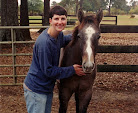April 12, 2012
Listening to your gut
April 8, 2012
Joy, ease, and lightness
I’ve been working with Lupin on tying for the past week or so and, suffice it to say, it’s been emotionally challenging for both of us. The only way I’ve been able to push Lupin enough to really test his tying is by introducing a cow into the equation, and yeah, that’s done the trick alright. Lupin tends to have bits of unconfidence mixed with defiance that only come out every now and then, so I’m trying to intentionally provoke him a little so that we can deal with these issues in a controlled setting. But even with that, it’s been a little scary.
I’ve been concerned to keep both of us physically safe, and also concerned, as he plunges around on the end of the rope, that I am asking too much of my prey animal. Is it fair of me to ask Lupin, who is genuinely bothered by the cow, to stand tied on the outside of its pen?
But I learned in the Fast Track course that the only way to find out if you are doing the right thing for your horse is to try something and see what happens. There are no guarantees that you’ll get it right. In fact, it’s almost certain that a lot of the time you won’t. But as long as your intention is to do something for your horse rather than to him, you are on the right track even when you make mistakes.
My confidence that I am on the right track with this specific approach, however, was severely tested a couple of nights ago when, just as it seemed we had made real progress, Lupin suddenly blew his lid, started violently pulling back, and even flipped himself over, despite the fact that the blocker tie I used gave him a lot of slack when he needed it.
I had some dark hours of doubt after that. I back-pedaled and did more preparation playing games around the pen, and then I simulated tying by sitting on the fence myself and holding the rope. And I called my left-brain horse guru Alex to get an outside perspective and some moral support.
All of that helped. But what really helped was when I came across a line in one of Eckhart Tolle’s books: “Is there joy, ease, and lightness in everything you do?” I thought about this. What I was doing with Lupin had begun to feel like gutting it out and being stuck on a path that I couldn’t get off of more than enjoying my horsemanship journey.
Today I decided to go out with the attitude of keeping joy, ease, and lightness in our entire session. To me, that translates this way:
Joy.
Staying in and enjoying the present moment ('I'm getting to play with my horse!') instead of focusing on the goal (in this case worrying about getting Lupin to be totally okay with tying). This helped me meet Lupin where he is right now and be pleased with what he is offering and able to do, rather than concerned about what he can’t yet do ('and oh my god! what if he never learns?!'). Less focus on the goal also made it easier to do a lot of approach and retreat—accepting less and rewarding more.
Ease.
I can’t expect zero brace in my horse if I have brace in myself. I focused on my own rhythm and relaxation so that Lupin could have some chance of finding those things himself. We practiced, for instance, turning slowly away from the cow with fluidity rather than beating a hasty retreat.
Lightness.
For me this is mental lightness—not making such a big deal out of everything and having a little bit more of a playful spirit, even in the face of a scary cow. From Lupin, I want physical lightness (which is a good indication of how much he’s trusting me and following my lead). Interestingly, when I focus on his lightness—when I make that the goal—I start to feel more like I’m dancing with my horse and less like we’re confronting something scary.
And everything felt so much better. I was able to problem solve more creatively: I experimented with reverse psychology by demanding a really fast backup in the yo-yo game so that going backwards fast from the cow would start to seem less appealing to Lupin (since it wasn’t his idea any more). I also started to want to be more engaged in the process rather than keeping my distance: I put the rope around a post so that I could control it more rather than relying on the blocker tie I had been using. And I felt much more connected to Lupin throughout the whole session.
So my new goal is to have joy, ease, and lightness in myself and see if maybe, just maybe, Lupin starts to have more of that as well. Whatever happens, though, this way is bound to be a helluva lot more fun.



